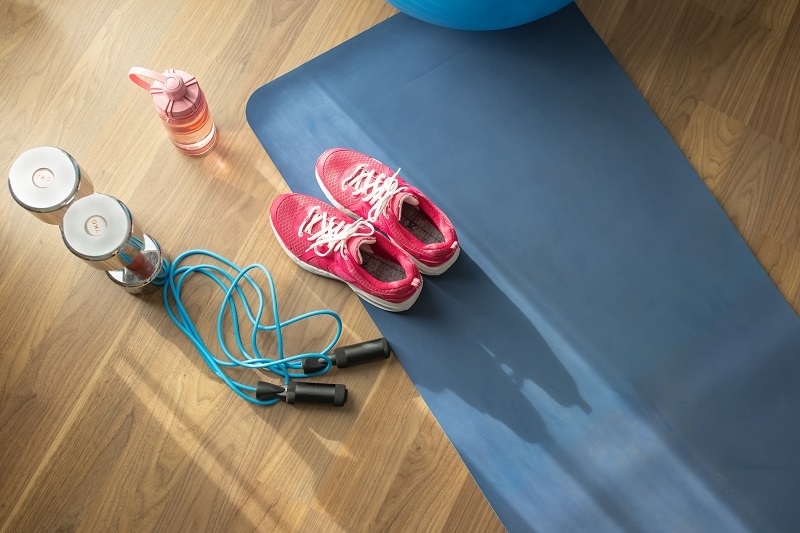
If you're beyond the grasp of gym membership prices or simply can't manage to get yourself into a gym, do not worry: it's never been simpler to develop a feasible and convenient at-home beginner workout routine. Regardless of what your limited space, equipment, or time, there's always a solution to getting fit with persistence and creativity in application.
The best thing about home workouts is that they cut out the excuses. You don't need machines, massive weights, or a drill sergeant yelling in your ear. With some room for your feet and the will to do it, you can turn no-equipment exercises into a good program that puts you in calorie-burning, muscle-building, endurance mode.
Let us break down how you can build a well-balanced weekly fitness plan at home, specifically if you are a beginner at exercising.
Take a minute or two prior to exercises to consider the reason you are doing it. Is it to lose weight, build lean muscle, improve cardiovascular efficiency, or simply to feel more energized on a daily basis?
A goal will also keep you motivated and allow you to see how far you've progressed. Your routine does not need to be super complex. Honestly, when you're creating a home workout routine for beginners, the less complex, the better, if general fitness and just getting active is what you're after, your routine will need to include some strength, cardio, and mobility work.
One of the biggest errors beginners make is that they try to do too much at a time. You do not need to exercise for an hour a day. A total of 20–30 minutes a day is more than enough, especially if you are a beginner exerciser.
To be consistent, try to schedule a specific time of day to exercise. Mornings are best for energy, and nights are best for stress relief. The idea is to make your exercise a non-cancelable appointment.
The weekly home workout routine must target all the muscle groups and must have at least one day of active recovery. It must also be practical. If you do 10-hour workdays or have children to mind at home, shorter but more intense workouts are better than longer workouts.
The secret to a great starter home workout routine is to learn bodyweight exercises. They're simple, effective, and can be adjusted for anyone's fitness level. They also get you in shape without gyms or gym equipment.
Some of the foundational movements are:
Squats: Work your glutes, thighs, and calves. They also engage your core.
Push-Ups: Excellent for your shoulders, arms, and chest. Do incline or wall push-ups if you need to.
Planks: Strengthen your stability and core.
Lunges: Activate your glutes, quads, and hamstrings and develop balance.
Jumping Jacks: Excellent for warming up your heart and burning calories.
Glute Bridges: Develop strong hips and lower back without unnecessary joint stress.
These are bodyweight exercises that you can scale up. To increase the intensity, do fewer resting periods or more reps. If you find yourself getting stronger in some weeks, make circuits by doing 4–5 exercises and repeating them with as short a break as possible in between.

When scheduling a week of home workouts, the goal is to get a mix of strength, cardio, and mobility. The following is a foundational plan to begin with:
Monday – Full Body Strength: Work using bodyweight exercises like squats, lunges, and push-ups. Two sets of 8–12 reps each.
Tuesday – Cardio + Core: Switch between jumping jacks, high knees, mountain climbers, and planks for a quick high-intensity workout.
Wednesday – Lower Body Focus: Squats, bridges, and reverse lunges come to mind. These are ideal for creating base strength.
Thursday – Active Recovery: Gentle stretching, yoga, or a 30-minute walk. Recovery is the name of the game.
Friday – Upper Body + Core: Push-ups, shoulder taps, planks, and glute bridges are an excellent way to round out your week.
Saturday – HIIT Session: Alternate between short bursts of high-intensity work (like burpees or jump squats) and short bursts of rest.
Sunday – Rest: Let your body recover for the week to come.
This is a good all-around and easy home workout routine for beginners and will work into almost any schedule.
Repetition forms habit, but variety keeps boredom at bay. As a beginner, motivation vanishes the minute workouts get boring. So you need to find new beginner workouts that shake things up.
Some ideas to shake up the routine include:
Dance Workouts: Try dance cardio or YouTube Zumba videos. They are high energy and fun.
Stair Workouts: Use home stairs to perform step-ups or cardio circuits.
Animal Movements: Bear crawl, crab walk, and frog jumps engage your muscles differently.
Creative Tools: Light weights created from water bottles or sliders created from towels.
The trick is to continuously challenge yourself and get bored quickly. The sillier you are when performing your exercises, the more you'll be inclined to stick to your weekly fitness plan at home.
It's easy to turn fitness into a fix-it, but long-term results are a product of long-term habit. Once you're habituated, working out at home feels like second nature. More importantly, it feels like something to which you're progressive.
Don't beat yourself up if you miss a day or fall off the wagon. Just get back on again the following day. Fitness isn't about perfection—it's about momentum. By building in flexibility, fun, and achievable goals into your routine, you will develop the resilience that will have you coming back.
A solid home workout is only half the fight. You also need to eat properly and allow your body time to recover. If you don't eat properly and rest, you will never feel the impact of everything that you are doing.
Hydration: Keep drinking water throughout the day, not just when you're exercising.
Nutrition: Lean protein, complex carbohydrates, veggies, and fruit.
Rest: Try 7–8 hours of sleep each night to help you recover.
Stretching: Complete each session with some light stretching to prevent soreness and enhance flexibility.
These routines supplement your bodyweight training to allow you to build a robust, functional body.
If you begin a beginner home exercise routine, it is pleasant to monitor your progress. Note the exercises that you have done, how you felt, and whether you can notice a difference in your energy level, stamina, or body shape in a notebook, app, or calendar.
By monitoring your inconsistency, as easy as checking off days on a calendar, you'll be motivated. And before long, all those little successes will build up. You can look back and see just how far you've actually come. Down the line, you can modify your routine by adding reps, reducing rest, or trying middle-level movements. This is the way your routine keeps working for you as you get stronger.
Millions of people around the globe are finding that they can be fit without the gym. The comfort and convenience of working out at home cannot be beat. No waiting for equipment, no driving to the gym, no distractions—just you, your home, and your goal.
The secret ingredient of nutrition is intention. Set up a friendly exercise space. Roll out a mat, put on your music, and create a workout space. It doesn't have to be fancy. The idea is that it gets you moving.
You don't need weights or machines to become fit. A well-considered combination of no-equipment training, smart nutrition, and an active lifestyle will benefit you more than any gym membership.
You already have everything you need to be stronger, more energetic, and feel fantastic—in your own home. A well-structured and logical home exercise routine for beginners can completely transform the way you think, live, and move.
With 20-30 minutes of your time, a little floor space, and the resolve to make it stick, you can create a lasting fitness habit. From simple no-equipment exercises to enjoyable, beginner-friendly workout ideas, there are countless options for crafting your journey.
So go ahead and design your own weekly fitness plan at home. Be creative, be fun, and always remember: you can definitely get fit without a gym and gym equipment. You just need to have the motivation to start and the perseverance to follow through.
This content was created by AI